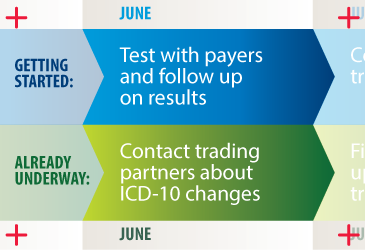As the clock ticks down to the Oct. 1 deadline to implement the ICD-10 code set, physicians should be prepping their practices. In Month Two of our ICD-10 primer, learn the next steps you should take.
What to tackle in June
Use these tips from the AMA and the Centers for Medicare & Medicaid Services’ Road to 10 Implementation Guide to bring your practice in line with the new code set.
Just getting started?
If you’re still in the early stages of preparation, spend your time next month contacting vendors about upcoming changes.
Most practices will need vendors to complete system updates to support the new code set. The two largest systems impacted will be your practice management system and your electronic health record system. You also may need to update your ePrescribing module, disease management registry or other systems.
Find a list of questions to ask your vendors on this tip sheet (log in).
This also is the time to communicate with your payers and related vendors, such as billing offices, and other physician practices and agencies from which your practice may seek advice, assistance or materials. Be sure to ask the insurers (log in) you contract with about payment changes, processes for “unspecified” codes and other information.
Already on your way?
If preparations already are well underway in your practice, now is the time to test your practice’s ICD-10 readiness and identify potential problems. There are different types of testing (log in), and each type serves a different purpose.
- Content-based testing assesses your practice’s documentation and ability to code in ICD-10. It involves being given documentation and coding a clinical scenario in the new code set. The Healthcare Information and Management Systems Society offers resources for your practice.
- Internal testing evaluates your practice’s ability to create and use ICD-10 codes throughout the patient work flow where you currently use ICD-9 codes. This type of testing requires system upgrades to be installed already and helps you follow the flow of a patient through a visit to see where codes are used. Use this testing to identify any gaps in your ICD-10 updates.
- External testing tests your practice’s ability to send and receive transactions that use ICD-10 codes with your external trading partners, including your billing service, clearinghouse or payers. Check with these groups about their testing plans. One type of external test is acknowledgement testing with Medicare, which simply acknowledges that a claim has been received. Physicians can do acknowledgement testing with their Medicare Administrative Contractors and the Common Electronic Data Interchange contractor any time up to the Oct. 1 implementation date. Medicare, however, has placed special focus on specific weeks. The last such week will be June 1-5.
Easing the transition
AMA efforts to ease the burden of ICD-10 implementation on physicians continue. Still, experts caution that physician practices should make sure they are prepared for the Oct. 1 deadline.
Visit the AMA ICD-10 Web page to access additional information and resources to help you prepare. An ICD-10 data file available on CD-ROM or via immediate download also is an essential resource.
Editor’s note: This post is the second part of a new monthly series that will provide timely transition tips and resources as the Oct. 1 ICD-10 implementation deadline approaches. See the first post, and learn what your practice should do to prepare financially for ICD-10.





